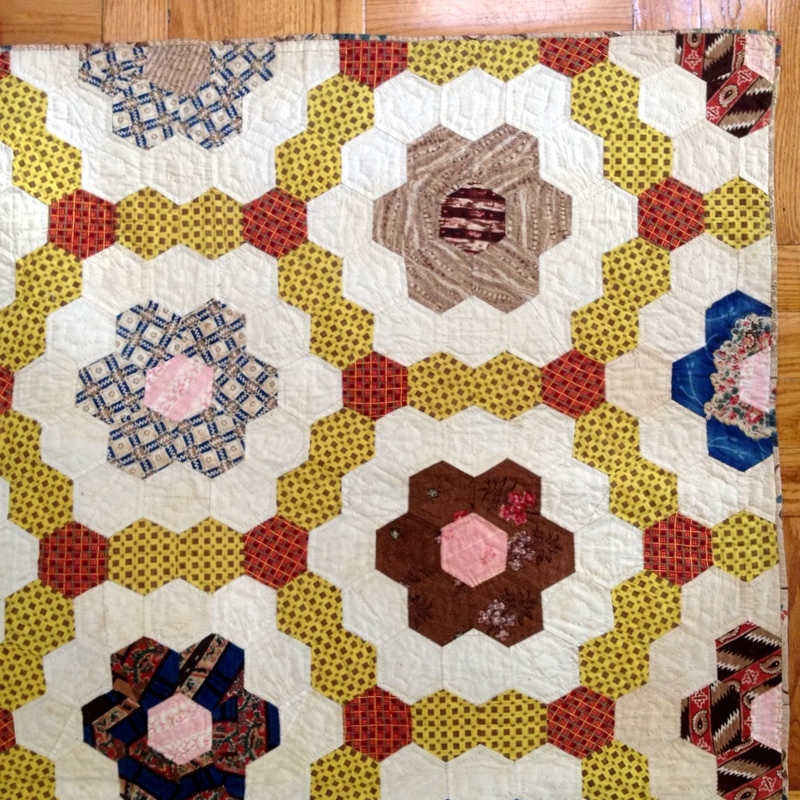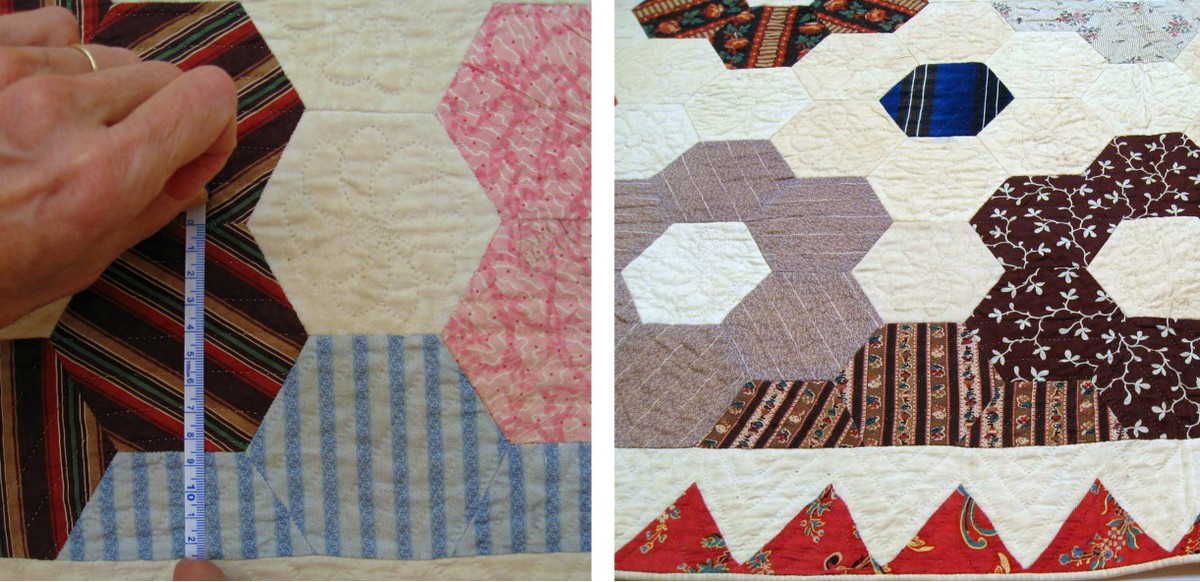Word is I’ve never been fond of the hexagon shape; I think it looks boxy. The first hexagon quilts I saw were mid-20th century Grandmother’s Flower Garden rosette patterns. I didn’t care for pastels nor the ratio of muslin background against the rosettes. You’d think my aversion was because I grew up wearing clothing made from feedsack cloth but that wasn’t so. If only I had first seen 19th century Honeycomb quilts.

My pocketful of memories
My history with hexagons
Over 20 years ago I needed handwork for an every other Monday night quilting bee. I took up with, would you believe, hexagons and experimented with fabric supports other than card stock. A remnant of that time is, ironically, my own grandmother’s change purse. It’s still full of those early hexies. As I’ve always preferred to piece everything by machine, I moved on to hand appliqué for the bee. Now I smile at the sight of my two homemade Mylar hexagons that my late husband once labeled for me.

Though I’m not crazy for the hexagon shape by itself, it’s versatile. I machine pieced a reversible quilt. The hexagon shapes on the front are composed of 60-degree diamonds. It’s a sly hexagon that isn’t “boxy.” I wrapped the diamond edges to the back and machine quilted each unit before joining them together. My hexagonal Vice Versa quilt was completed in 2002. Occasionally I teach it as a workshop to quilt guilds. A close up of it is in the video below…

Left: The front bottom right detail of the quilt; Right:: Right: The quilt flipped over (akin to turning over a fried egg)

The above quilt in my collection is reversible. It’s tied rather than quilted. Geese on the back, Hexagons on the front. Yowza! I have a penchant for eccentric quilts.

I couldn’t resist purchasing the above quilt. I was captivated by its mid-19th century fabric and yellow partial pathways. The red hexagons interrupt the usual circular setting; it no longer resembles a box in a box in a box. Look at the quarter block in the upper right. I believe it was cut from the rosette at the bottom right. I find layouts for hexagon quilts to be quirky as by nature they’re asymmetrical.

Hexagon or Honeycomb pattern Quilt by Rebecca Davis, 1846
I examined this quilt and snapped these pictures in 2008. The use of fabric, the hand quilting, and dog-tooth border design are splendid. The entire quilt, in the collection of the Metropolitan Museum of Art, may be seen here.
While viewing the quilt please take note of its setting, not just the borders but the almost “invisible” light hexagons with dark centers used as a contrivance, which make the quilt symmetrical. Compare it to the setting in the quilt detail below. With permission, my hand appears near the quilt to show its scale.

Hexagon Quilt, circa 1880, Sweden
From me to you: A free template for how to cut a hexagon
From those Monday night bee meetings forward, I’ve had a fascination with hexagons. I keep an entire dresser drawer full of hexagon ephemera. The change purse lives in it as did my 2004 drawing for a hexagon cutting pattern.
I’ve let the pattern for how to cut a hexagon out of the drawer and made it available for free download. Use it with a 10-inch square of fabric to efficiently cut out seven hexagons and four half hexagons for English paper piecing.
Watch my video demonstration of the pattern. It’s not of the quality of a Craftsy video, you’ll even hear a phone ring once, but it is an indication of the techniques I teach in Traditional Blocks Made Simple.

Share tips, start a discussion or ask one of our experts or other students a question.
No Responses to “The Fiber of My Being: Hexagons Seen Through My Eyes”